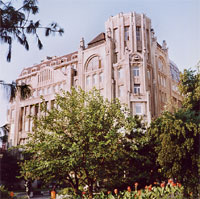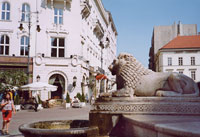| The
Danube, I'm sorry to report, is not blue. That head-swinging waltz title no longer
rings true. The great river - broad with a brutish current - slugs through the
twin cities of Buda and Pest. The city sometimes adds azure dye on state occasions.
Most days, however, it's gray-brown, a toad-tone uninspiring to lyricists, photographers
and tourists alike.
 |
| Szent
Istvan's Basilica honors nation's father & 1st Catholic king. |
Everyone
tries to like Budapest, though. Eastern Europe is trendy - and the recent EU expansion
only added cache. Hungary is arguably the most solid and sane of the former Soviet
Bloc countries. The capital has eclectic architecture, a glorious history, 123
hot springs, park swathes and girdling forests: all prime ingredients for a magical
destination. So why do travelers sour on the Danube's shores? The
common consensus is this: Budapest is a beautiful city, crippled by the people-handling
skills of a Communist thug. Take
the spas, for example. These pleasure domes are legendary for their ornate decor,
floating chessboards and hedonistic - excuse me, healthful - pools. I ventured
into the gilded heart of decadence, the Gellert Hotel Baths, where Saint Elizabeth
supposedly cured lepers. The
building's turrets, soaring ceilings and gleaming wood certainly massed muster.
Yet at the elegant ticket kiosk, visitors struggled with the bewildering array
of options. Bath and steam? Open-air pool? Locker or bathing cabin? How many forints
was that exactly? Confusion
is not chic - and the Gellert was rife with it. The attendants seemed actively
malicious, confiscating chits needed farther along (each bather is issued a handful
of receipts, all handily labeled in Hungarian, a language kin only to Finnish
and famed for its difficulty). I
padded through the labyrinth of changing cubicles, exchanging irritated glances
with other guests. Support groups formed, sending out the bravest soul in search
of the fabled towel depot. A Canadian girl wept, having lost her camera - and
weeks of film - in the scrum. Sharp-tongued staff scolded the customers. What
next? Another rant because my receipts were damp (big surprise there)? A swirlie
from a scowling, barrel-limbed masseuse?
Just
as I was ready to flee the spa - and the country - I floundered into the central
pool pavilion. The Art Nouveau gallery was exquisite, all stunning skylights and
mosaics, a vision from a pasha's harem.
Unfortunately,
Budapestian bureaucracy had invaded this sanctuary too. Angry black arrows dictated
that swimmers circulate clockwise. The pace was brisk, as stocky, pink-jowled
men charged round the circuit. Each wore the mandatory Gellert bathing cap and
resembled nothing so much as a very determined walrus with a lumpen grocery bag
trailing off his head.
Preferring
a convivial soak, I headed for the bustling smaller tank, where stone lions spurted
hot water. The experience was not relaxing at all, to say the least. Signs - multi-lingual for once -forbid
floating. The guests clung to the benches, but such obedience didn't spare us.
Soon two attendants arrived and began bellowing in Hungarian, waving vaguely into
the crowd. Bathers shifted around, trying to intuit what the problem might be.
Don't sit under the faucet? Avoid blocking the sign? Go away and spend your capitalist-pig
earnings elsewhere?
Like
me, many gave up and left. The shouts continued to bounce off the marble, echoing
into the Tower of Babel dressing room. I couldn't leave quick enough - and almost
screamed myself, when the refund system slowed my headlong charge for freedom
and fresh air.
Later,
insulated by a pint or two of beer, I mellowed. Tomorrow, I decided, would bring
a fresh start, a second chance. I drifted along in a romantic, forgiving, and
misty mood - and thus missed the last metro across town...at the absurdly early
hour of 11pm.
The
capital's taxi drivers are notorious for fleecing visitors, so my companion and
I set off trekking. Nothing like a six-mile constitutional stroll after a rich
dinner. Budapest was not racking up brownie points. Once again, I hated it.
An
hour later, my resistance was melting down, however. We'd passed innumerable lively
cafes, spilling crowded tables and bright umbrellas onto the sidewalks: scenes
straight from Athens or Rome, transplanted to this colder clime. Entwined couples
strolled down cobbled streets. Cheerful shouts escaped from open-air clubs, pulsing
with music. Granted, they were horrible Kraftwerk-style techno tunes, but overall
the atmosphere was light, playful even - a far cry from the spa labyrinth.
We
wandered along the mighty Danube, now a broad inky ribbon reflecting the city's
thousand points of light. A golden glow illuminated fin de siecle architecture,
bulbous onion domes, the rock-hewn Cliff Chapel, craggy Castle Hill and the imposing
Parliament. Tiny bulbs traced the famous Chain Bridge, oldest in the area. Night
breezes hinted at forested slopes and green meadows just over the horizon. Hungary's
capital was fairytale perfect under the pinpoint stars and pale moon.
I
relented. Budapest deserved a chance, despite the trains, the bureaucratic blundering
and intimidating haunches of meat, smothered in cream sauce and paprika, dominating every menu.
The
morning dawned bright and crisp, hinting at autumn. We crossed the river, bound
for Vorosmarty Square, one of Budapest's most elite addresses. Gerbeaud, a 145-year-old
cafe, lies there. If the legendary decor, coffee and pastries couldn't win me
over conclusively, nothing would.
This
Budapest institution didn't disappoint. The ambience was fantastically fussy with
marble tables, gold wallpaper, shiny brass and velvet drapes, and all the trappings
of the Austro-Hungarian glory days. The posh piano was destined for the Titanic,
but missed the boat because of construction delays.
The
drinks, admittedly, didn't live up to expectations. Hungarians take caffeine very
seriously. A proverb even dictates that "coffee should be black like the
devil, hot like hell, and sweet like a kiss". Gerbeaud, cranking out cups
for the tourists, fell more into the lukewarm and lackluster camp, but the setting
and confections more than compensated.
We
lounged in wicker chairs outdoors, as pigeons and children wheeled about the famous
square. A leafy clump of trees and monumental statues broke up the vast space,
fringed with elaborate mansions.
 |
Budapest
is pocketed with parks and spectacular Art Nouveau and eclectic architecture. |
The city's
glamorous commercial district begins here at Vorosmarty. Stalls line the side
streets, packed with leather goods, predominantly gem-colored wallets. Bijou boutiques
showcase hand-embroidered linens next door to glamorous chain stores along the
Vaci utca. 'White-gold' porcelain - favored by Queen Victoria - is sold here,
as is the local red vintage, Bull's Blood (Bikaver) and the world-famous Tokaj.
This "noble rot" dessert wine, aged in volcanic rock cellars, even merits
a few lines in the national anthem.
A
tolerant smile stretched across my face, as sunshine glittered on the window displays
and bright Hungarian flags cracked in the wind. Now this wasn't so bad: cosmopolitan
and elegant, yet alien enough to be interesting.
Budapest,
I found, is much like the Danube River it embraces. Muddy waters also run deep
- and in the right light - can beguile with the best of them.
IF
YOU GO |
Transport
Budapest Ferihegy airport is 15km outside the city center (www.bud-airport.hu).
Carriers include Malev Hungarian Airlines (www.malev.hu)
and British Airways (www.britishairways.co.uk).
Consider flying to London or another major European city, then catching a Sky
Europe no-frills flight to Hungary, for as little as 50 euros one-way (www.skyeurope.com).
Airport taxis have a poor reputation. Take the Shuttle "Minibusz" for
2,100ft instead (3,600ft round-trip; tel: 296-8555). Budget travelers should catch
the local 93 bus to Kóbánya-Kispest metro station for 106ft (total
journey time around 45 minutes).
The
capital has three international rail stations: Keleti, Nyugati and Déli,
all on the metro lines (www.elvira.hu).
The international coach station is Népliget (219-8080). Hydrofoils run
to Vienna and Bratislava between April and October, except during droughts (318-1223).
The
metro, trams and buses are excellent, though the tickets can be confusing (www.bkv.hu).
Purchase them at underground stations, tobacconists and newsagents. A single (vonaljegy)
costs 105ft. To transfer lines, however, purchase a 240ft ticket (átszállójegy).
Validate the ticket before you enter the metro (watch out for the dreaded 'white
line'. Police target disoriented visitors who wander across this without punching
their ticket).
Tourists
may prefer the simplicity of a 1,150ft day pass or 2,300ft three-day pass. The
Budapest card - a sightseeing pass - includes free transport (4,350ft for two
days, 5,450ft for three). Reputable taxi companies include Budataxi (233-3333)
and City Taxi (111-111). A 10% tip is customary.
Where
to stay
The Hostel Fortuna offers singles, doubles, triples at
quads at affordable prices (Gyáli út 3/b; 215-0660; www.hostels.hu).
Buda's Hotel Papillon is also a boon to modest budgets. The rooms are surprisingly
large and light, plus facilities include a beer garden and tiny swimming pool
(Rózsahegy utca 3/B; 212-4750).
Follow
in the footsteps of bigwigs like Brezhnev, Gorbachev and Yeltsin at the Hotel
Andrássy, once a Communist party resort (Andrássy út 111;
tel: 462-2100; www.ohb.hu/andrassy).
Or check out the hype at the new Art'otel. American artist Donald Sultan has mixed
moderne design with eighteenth-century Baroque townhouses in this gracious, spacious
hotel (Bem Rakpart 16; tel: 487-9487; www.artotel.de).
Where
to eat
Funky Remiz - meaning "tram depot" - resembles
a white-brick street car, stuffed with fake columns, live musicians and cheery
diners, savoring meats grilled on lava stone (Budakeszi út 5; 275-1396).
Apostolok offers a more sedate experience with just a dash of religious kitsch:
stained-glass windows and church-pew booths named after the Twelve Apostles (Kígyó
utca 4; tel: 267-0290). Panicked vegetarians seek refuge in the soothing Bangkok
House Restaurant. They're in good company, judging from the portraits signed by
Madonna and Yoko Ono, praising the delicate Thai cuisine (Só utca 3; tel:
266-0584).
Chic
Gundel remains the capital's most famous - and expensive - eatery (Állatkerti
krt 2; tel: 468-4040). Belcanto steals the spotlight, however, with operatic waiters
(Dalszínház 8; 269-2786; www.belcanto.hu). On the down-market chic
side, Marxim's weighs in with barbed wire, communist murals and decent pizzas
(Kisrókus utca 23; tel: 316-0231).
Information
The tourism office produces an excellent two-euro guide to the city (488-0475;
www.budapestinfo.hu). Tourinform offers advice 24 hours a day (Vörösmarty
tér; 438-8080; www.hungarytourism.hu).
English language papers include the Budapest Sun (www.budapestsun.com)
and Budapest Week (www.budapestweek.hu).
Another excellent resource is the quarterly publication, Budapest in Your Pocket
(www.inyourpocket.com). |
|